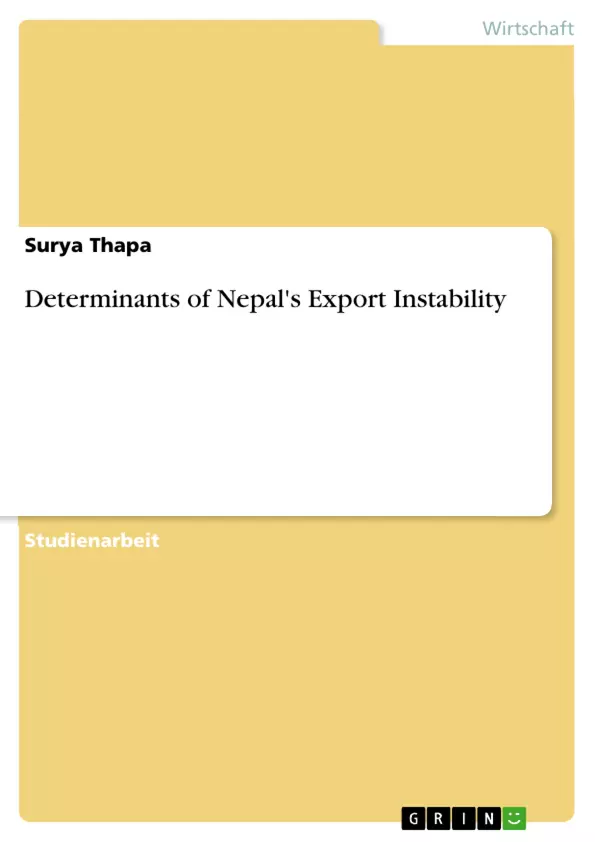Fluctuation in export earnings is a great concern to policy makers and can be caused by many factors. This study has analyzed the causes of export instability from 1980/81 to 2012/13 based on secondary data. Using Ordinary Least Square technique the empirical result shows that there is positive relationship between export instability index and three independent variables: commodity concentration index, geographic concentration index and openness index. Furthermore, it again establishes the negative relationship between export instability index and four independent variables: consumption ratio, food ratio, instability index of real agricultural GDP and instability index of real nonagricultural GDP having coefficients of -2.922, -7.633, -5.169, and -0.474 respectively.
Inhaltsverzeichnis
- Abstract
- Background
- Size and Trend of Export Trade
- Nominal Export and Import Trade
- Real Export and Import Trade
- Direction and Growth Rate of Export Trade
- Commodity Concentration Index
- Geographic Concentration Index
- Openness Index
- Consumption Ratio
- Food Ratio
- Instability Index of Real Agricultural GDP
- Instability Index of Real Nonagricultural GDP
- Empirical Findings and Interpretation
- Policy Implication
- Conclusion
Zielsetzung und Themenschwerpunkte
Die Studie befasst sich mit der Analyse der Ursachen für die Instabilität des Exportwachstums in Nepal zwischen 1980/81 und 2012/13. Sie untersucht, welche Faktoren den Schwankungen der Exporterlöse beitragen und wie diese mit der Wirtschaftsentwicklung des Landes zusammenhängen.
- Die Analyse der Faktoren, die zur Instabilität des nepalesischen Exporthandels beitragen
- Die Untersuchung des Zusammenhangs zwischen Exportinstabilität und Wirtschaftswachstum
- Die Bewertung der Auswirkungen von Handelspolitiken auf die Exportentwicklung
- Die Identifizierung von Strategien zur Stabilisierung des Exporthandels
- Die Bedeutung der Diversifizierung der Exportgüter und der Erschließung neuer Märkte
Zusammenfassung der Kapitel
- Abstract: Die Studie untersucht die Ursachen für die Exportinstabilität in Nepal mithilfe von Sekundärdaten von 1980/81 bis 2012/13. Die Ergebnisse zeigen einen positiven Zusammenhang zwischen dem Exportinstabilitätsindex und verschiedenen Faktoren, wie dem Warenkonzentrationsindex, dem geografischen Konzentrationsindex und dem Offenheitsindex. Außerdem wird ein negativer Zusammenhang mit dem Konsumverhältnis, dem Nahrungsmittelverhältnis, dem Instabilitätsindex des realen landwirtschaftlichen BIP und dem Instabilitätsindex des realen nichtlandwirtschaftlichen BIP festgestellt.
- Background: Der Exporthandel spielt eine wichtige Rolle für die wirtschaftliche Entwicklung Nepals. Trotz der Bemühungen der Regierung, den Exportsektor zu fördern, bleibt das Land stark von Indien abhängig und zeigt ein instabiles Exportwachstum.
- Size and Trend of Export Trade: Der Beitrag analysiert die Entwicklung des nominalen und realen Exports und Imports in Nepal. Die Ergebnisse zeigen, dass sowohl der Export als auch der Import in den letzten Jahren gestiegen sind. Es wird jedoch festgestellt, dass das Exportwachstum instabil und volatil ist.
- Direction and Growth Rate of Export Trade: Die Studie untersucht die Ausrichtung des nepalesischen Exporthandels und stellt fest, dass Indien der wichtigste Handelspartner ist. Der Einfluss der Handelsliberalisierungspolitik auf die Exportentwicklung wird diskutiert.
- Commodity Concentration Index: Dieser Abschnitt analysiert den Einfluss der Warenkonzentration auf die Exportinstabilität. Ein hoher Warenkonzentrationsindex deutet darauf hin, dass der Export von wenigen Produkten dominiert wird, was zu erhöhter Instabilität führen kann.
- Geographic Concentration Index: Die Studie untersucht den Einfluss der geografischen Konzentration auf die Exportinstabilität. Ein hoher geografischer Konzentrationsindex deutet auf eine starke Abhängigkeit von einem bestimmten Markt hin, was ebenfalls zu erhöhter Instabilität führen kann.
- Openness Index: Der Abschnitt analysiert den Einfluss des Offenheitsindex auf die Exportinstabilität. Ein hoher Offenheitsindex zeigt eine größere Integration in den Weltmarkt an, was zu einem stabileren Exportwachstum führen kann.
- Consumption Ratio: Die Studie untersucht den Einfluss des Konsumverhältnisses auf die Exportinstabilität. Ein hohes Konsumverhältnis kann zu einem geringeren Exportwachstum führen, da ein größerer Teil der Produktion im Inland konsumiert wird.
- Food Ratio: Der Abschnitt analysiert den Einfluss des Nahrungsmittelverhältnisses auf die Exportinstabilität. Ein hohes Nahrungsmittelverhältnis kann zu einem geringeren Exportwachstum führen, da ein größerer Teil der Produktion für den Eigenbedarf verwendet wird.
- Instability Index of Real Agricultural GDP: Die Studie untersucht den Einfluss der Instabilität des realen landwirtschaftlichen BIP auf die Exportinstabilität. Schwankungen im landwirtschaftlichen Sektor können sich auf die Exportentwicklung auswirken.
- Instability Index of Real Nonagricultural GDP: Der Abschnitt analysiert den Einfluss der Instabilität des realen nichtlandwirtschaftlichen BIP auf die Exportinstabilität. Schwankungen im Industriesektor können sich ebenfalls auf die Exportentwicklung auswirken.
- Empirical Findings and Interpretation: Dieser Abschnitt präsentiert die empirischen Ergebnisse der Studie und interpretiert die Ergebnisse im Kontext der nepalesischen Wirtschaft.
- Policy Implication: Die Studie diskutiert die politischen Implikationen der Ergebnisse und schlägt Maßnahmen vor, um die Exportinstabilität zu reduzieren und das Exportwachstum zu fördern.
Schlüsselwörter
Export, Exportinstabilität, Warenkonzentrationsindex, Geografischer Konzentrationsindex, Offenheitsindex, Konsumverhältnis, Nahrungsmittelverhältnis, Instabilitätsindex des realen landwirtschaftlichen BIP, Instabilitätsindex des realen nichtlandwirtschaftlichen BIP, Nepal
- Quote paper
- Surya Thapa (Author), 2018, Determinants of Nepal's Export Instability, Munich, GRIN Verlag, https://www.grin.com/document/491563



